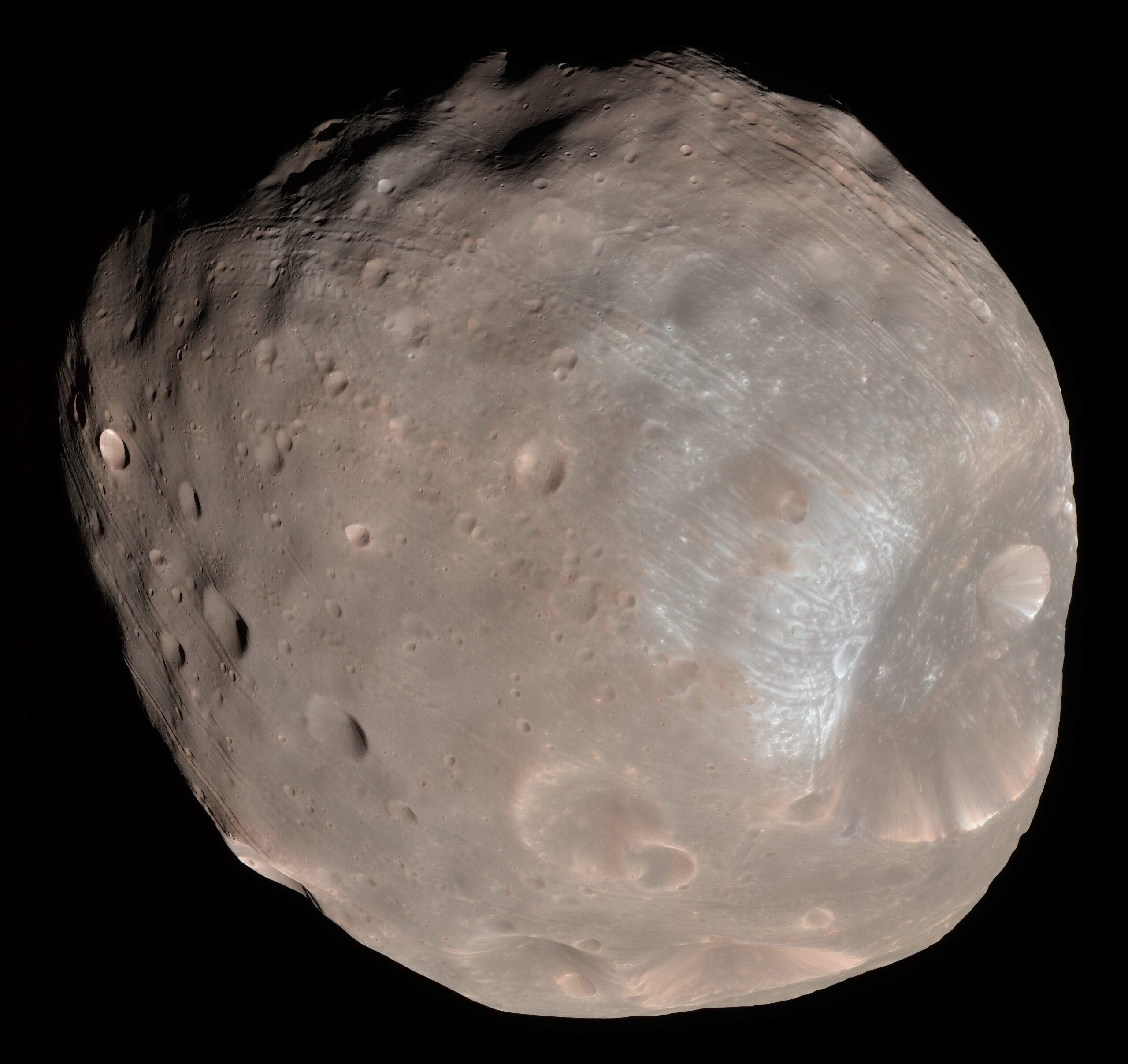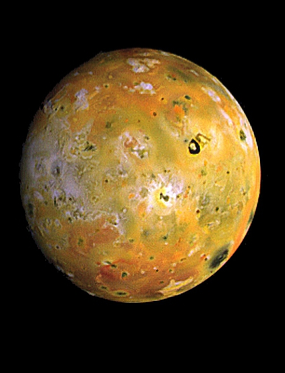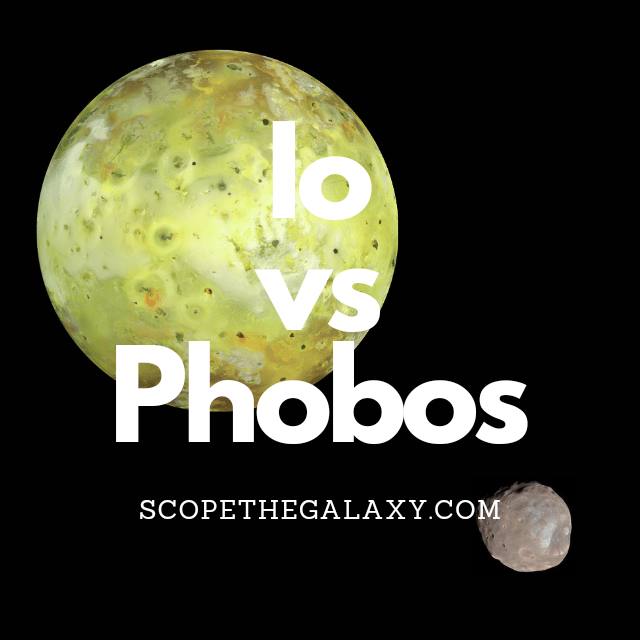*This post may contain affiliate links. This means we may make a commission if you purchase an item using one of our links*
The main differences between Phobos and Io are that Phobos is far smaller with a diameter of 22.53km compared to Io’s 3,643km, Io is the most volcanically active entity in our solar system while Phobos has no volcanic activity and Io orbits Jupiter while Phobos orbits Mars.
There are various other differences between the two so, continue reading to learn more about these natural satellites along with their similarities and differences below.
What Is The Moon Phobos?
Table of Contents

Phobos is the larger and innermost of the Martian moons, named after the Greek God of fear and panic. This rocky satellite measures approximately 27 x 22 x 18 kilometers and possesses an irregular shape.
Flying only 270 km above Mars’s surface, Phobos orbits the Martian surface so closely that it spins around the planet three times a day (each orbit takes 7 hours and 39 minutes). And this proximity means that the moon cannot always be seen from Mars’ surface (it all depends on where you’re standing).
In general, Phobos rises in the west, passes through the sky in around 4 hours, and sets in the east. And this process occurs twice during one Martian day.
Phobos travels 1.8 m closer to Mars every 100 years, which means this doomed moon will one day crash into its planet or break up into rings. Still, this won’t happen for another 50 million years or so.
The moon is covered in streak patterns from impact craters, the most significant of which is the crater Stickney, with a diameter of 9.7 km. Phobos has weathered thousands of meteorite impacts, one of which almost shattered it to pieces.
It was first discovered by the American astronomer Asaph Hall on 17th August 1877. But, it can be difficult for astronomers to see as it is one of the least reflective bodies in the solar system with an albedo of 0.071.
Despite its small stature, Phobos experiences wildly varying temperatures on its dark side compared to the light side. Measurements on the light side of the moon suggest that temperatures can rise to -4 degrees Celsius, a sort of brisk winter’s day that would be cold but tolerable.
In contrast, temperatures on the dark side can drop to -112 degrees Celsius, even though the two areas are just a few kilometers apart. The probable cause is fine surface dust that cannot retain heat, allowing temperatures to drop rapidly.
The low density of Phobos suggests its composition is similar to carbonaceous chondrite meteorites, which could mean that Phobos is a captured asteroid.
What Is The Moon Io?

The Moon Io – also known as Jupiter I – is the third largest of the Galilean moons, which has the closest orbit to Jupiter. It is the fourth-largest moon in our solar system by size – with a diameter of 3,643km – but has the highest density of all moons in the Milky Way.
In addition, Io has the strongest surface gravity of all moons and the least water by atomic ratio compared to any other astronomical object in our solar system.
Perhaps the most interesting feature of this lunar body is the 400 active volcanoes on its surface, which make it the most volcanically active object in the Milky Way; some of these volcanoes can exude plumes of sulfur to a height of several hundred miles.
The reason for this intense activity is the tidal heating caused by friction in the moon’s interior. Thanks to Io’s proximity to Jupiter, it finds itself caught between the gravity of its planet plus the two nearby moons – Ganymede and Europa. And this creates extreme tidal forces.
A side effect of these tidal forces is heat, which keeps most of Io’s crust in liquid form. Because of this, the surface of Io experiences a constant state of renewal; sites once home to large craters are slowly filled with molten lava and liquid rock.
While the complete makeup of Io’s surface is not yet defined, theories suggest that its main component could be sulfur and sulfur compounds because of the varied coloring. Silicate rock could also be a likely component as it would account for the high temperatures.
Io orbits Jupiter from a distance of around 422,000km, with an orbit that takes 42.5 hours to complete. Sitting 778,000,000km from the Sun, the surface temperature of this planet sits around -130 degrees Celsius. But due to the intense volcanic activity, the lava flows can reach temperatures of 1649 degrees Celsius, which is far hotter than anything on Earth.
Similarities Between Phobos And Io
As both are natural satellites, Phobos and Io do share a few similarities, which includes the following:
- Both have a rocky, terrestrial surface.
- Neither have rings surrounding them.
- Both are tidally locked to their planet.
- Both orbit their planet in an elliptical pattern.
- Neither have tectonic plates.
- Neither have a magnetic field.
- Europa and Phobos have a practically non-existent axial tilt.
Differences Between Phobos And Io
As for the differences between the two so, they include the below:
- Phobos orbits Mars whilst Io orbits Jupiter .
- Io is a spherical shape while Phobos is not.
- Io has a diameter of 3,643km whilst Phobos has a diameter of 22.53km.
- Phobos has no atmosphere whilst Io has a very thin atmosphere composed of mostly of a sulfur dioxide layer..
- A day on Phobos takes 7 hours 39 minutes whilst a Io day is 42 hours.
- It takes Phobos 7 hours 39 minutes to orbit Mars and around the Sun in 687 days whilst Io orbits Jupiter in 42 hours and the Sun in 12 years.
- Phobos’ temperature ranges between -4 to -112 degrees Celsius whilst Io’s is around -130 degrees Celsius.
- Io orbits Jupiter at an average distance of 422,000km whilst Phobos is 6,000km away from Mars.
- Io’s density is 3.53 g/cm³ whilst Phobo’s density is 1.88 g/cm³.
- Io is the most volcanically active entity in our solar system while Phobos is not volcanically active.
- Io’s mass is 1.345×10^23 kg whilst Phobos’ mass is 10.6 × 10^15 kg.
- Phobos’ gravitational strength is 0.0057 m/s² whilst Io’s is 1.796 m/s².
- Phobos only orbits Mars 6,000km away and is getting closer to the planet by 1.8 meters every 100 years.
Summary
Io and Phobos may both be one of multiple moons orbiting their respective planets and are tidally locked to their planets but, in the grand scheme of things they are very different from one another.
Whether it be in regards to mass, size, their volcanic activity, gravitational strength, how dense each body is, their shape and more. Therefore, despite the fact both are spherical and rock based celestial bodies, they have many distinct features that easily distinguish the two from one another.

